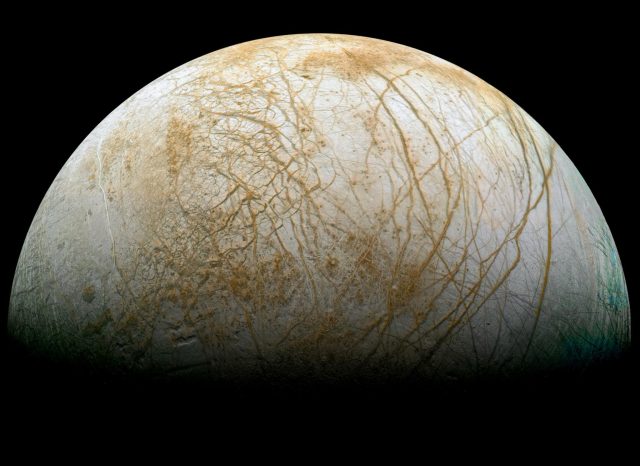Jupiter's moon Europa, a large world with a vast sub-ice ocean, is thought to be one of the best candidates for hosting life elsewhere in the Solar System. NASA has considered sending a lander to the moon's surface to see if its ice contains chemicals indicative of the presence of life, but that project is still in the evaluation phase.
A paper released on Monday explains what that mission will require in order to have a decent chance of finding these chemicals. To discover any pristine material, the lander will need to carry a drill capable of going at least a meter below the moon's surface.
Reshaping the surface
The gravitational strains placed on Europa by Jupiter and its other large moons are the energy source that keeps part of the moon's water liquid. But the liquid portion of Europa—thought to be a moon-wide ocean—is tens of kilometers below the ice on the moon's surface. So detecting evidence of life isn't a matter of peering down from orbit.
That said, researchers hope that this evidence could eventually end up where we could study it. There are indications that Europa's surface is reshaped by a process similar to plate tectonics, and we even have a hint that geysers may pierce Europa's ice. These processes could potentially bring materials from deep inside the moon to its surface, carrying either living things or chemicals associated with them.
One problem for any lander is what happens once the material gets there. The area near Jupiter is subject to intense radiation due to the giant planet's magnetic fields. In addition to instantly wrecking any organisms that survive the lack of atmosphere on the surface, the radiation would chemically transform the chemicals over time. We would find a difficult-to-interpret mix of organic chemicals instead of something we might clearly associate with life.
The obvious solution would be to look beneath the surface, as the ice would shield materials if they were sufficiently deep. But that's not guaranteed protection, given that the surface of Europa is also churned by impacts which, in the absence of an atmosphere, have no problems striking the surface directly.
To have a good chance of finding chemicals that reflect the moon's watery environment, we would need to dig or drill below both the depth of surface radiation and the depth that is likely to have been churned up by impacts.
How deep is enough
The new paper explores how deep we would need to drill. If we only need to get below the point where radiation would reach, we would only need to drill a few centimeters. The four researchers—all from US-based institutions—focused on whether impacts would churn the surface enough to require us to dig deeper.
The process, called impact gardening, can be modeled. To do so, we need to know some of the properties of the surface being impacted (ice, in this case), the frequency of impacts, and the size of those impacts. With this information, we could figure out the cumulative impact rate over time. We could also project forward to a point when the system reaches an equilibrium and craters disappear from the surface by being filled with debris at the same frequency that they're being generated.
The model is complicated by the fact that larger impacts spew out small debris that also create impacts when the material returns to the moon's surface, but that wrinkle can be accounted for as well.
Finally, we need to estimate the frequency of impacts and the size of the impactors. Two were commonly used in the literature: one based on a crater count using data from the Galileo orbiter, the second developed by counts of impact flashes. The researchers chose to use both of them, building separate models for each. In the end, they produced pretty similar results.
On Europa, impact gardening has churned the surface to an average depth of about 30 centimeters. Anything closer to the surface than that has at one time or another been exposed to enough radiation to chemically transform any materials it contains.
Old world
But Europa has been around for over 4 billion years, and there are many indications that parts of its surface are newer, and others are older. In all likelihood, little of Europa's surface has actually been in place for that entire period. More practically, if we assume we can land a probe in one of the newer areas, the odds of finding pristine material shift. For a location that's been on the surface for 10 million years, the researchers estimate that going deeper than one meter ensures that the material we find will not have been exposed to radiation.
To increase the odds of a successful mission, we'll need to focus on relatively young areas. The researchers also note that the radiation bombardment doesn't strike Europa evenly, so we could also target areas with lower radiation exposure. But even with those advantages, we will need to bring technology along that enables us to drill deeper than we've done on any body other than Earth.
Nature Astronomy, 2021. DOI: 10.1038/s41550-021-01393-1 (About DOIs).



3175x175(CURRENT).thumb.jpg.b05acc060982b36f5891ba728e6d953c.jpg)

Recommended Comments
There are no comments to display.
Join the conversation
You can post now and register later. If you have an account, sign in now to post with your account.
Note: Your post will require moderator approval before it will be visible.